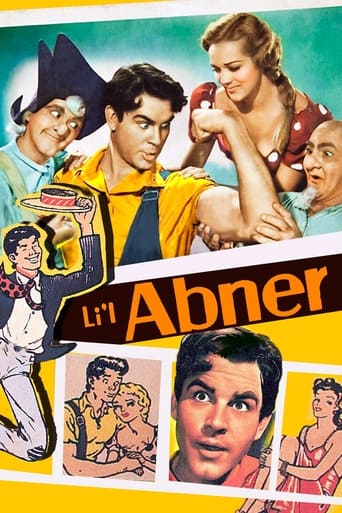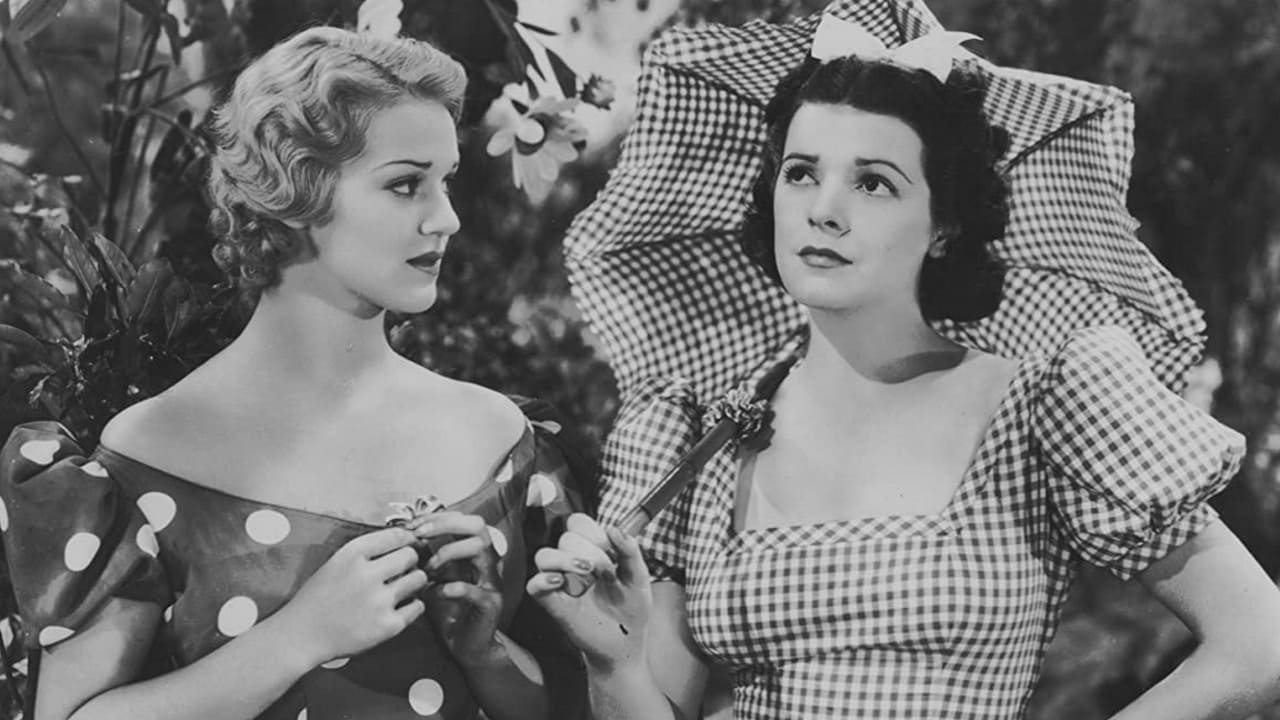JohnHowardReid
Copyright 1 November 1940 by Vogue Pictures, Ltd. No New York opening. U.S. release through RKO Radio Pictures: 1 November 1940. Never released in Australia, either theatrically or on television. 78 minutes.U.K. release title: TROUBLE CHASER.SYNOPSIS: Suffering a bout of indigestion after eating a Dagwood Bumstead sandwich, Li'l Abner is told by a mischievous barber that he has only 24 hours to live.NOTES: The plot of this one bears little relationship to the 1959 Paramount musical which was based on the very successful 1956 Broadway play.COMMENT: Here's a movie that fully deserved its poor reputation. In fact it's plain awful in just about every way. That's a pity because the producer had at least one worthwhile idea. By handing out parts to old-time comedians like Buster Keaton and Chester Conklin in theory he should have gladdened the hearts of picturegoers worldwide. Unfortunately, the witless script lets them down. In fact, aside from the decorative Martha O'Driscoll, the only featured player to give an attractive performance is Walter Catlett. I suspect he wrote his lines himself. Certainly he delivers them with a panache and style that serves to point up the amateurishness and signal lack of talent of most of the other players. I could go through the cast list awarding dishonorable mentions right and left, but it's most simpler to list those few such as Kay Sutton and Dick Elliott who are halfway competent. Indeed the introduction to Kay Sutton with the camera zeroing in on her eyes is just about the only touch of genuine flair the direction displays throughout. Fortunately the producer extended his love for the veteran slapstick comedians to the silent period generally, for he has given a job to Herman Raymaker, a successful director of the mid-twenties (e.g. the Rin-Tin-Tin feature, The Night Cry), who was forced into an early retirement a few years after the coming of sound (one of his last films, Trailing the Killer, made in 1932, starred Heinie Conklin who has a small part here). Raymaker directed the Walter Catlett scene as well as the climactic Sadie Hawkins Day race - and maybe even the Skunk Hollow chase as well. These scenes are certainly livelier than the rest of this tediously disappointing, elephantine movie. Hard to believe the waffley, non-satiric, schoolboyish story came from the pen of Al Capp himself. How could he disappoint his fans with such limpid tosh?
SnorrSm1989
By the time LI'L ABNER went into production, Al Capp's comic strip of the same name had been running for about six years and was well on its way of becoming a household name. Even so, the idea of putting Dogpatch to life on the silver screen was not as inevitable as one might think. While other popular comic strips of the day had made it to Hollywood already (Blondie, Bringing Up Father and The Katzenjammer Kids being some examples), the task of transforming real-life actors into representatives of the slightly grotesque Dogpatch-universe obviously was of another level. However, from a visual point of view the result is reasonably successful; it truly looks as if we've been granted a visit into the authentic li'l town. On other points, however, the film is hit-and-miss; mostly the latter.Capp himself is given credit as story writer, although his actual contributions to the script may have been sparse. However, on the surface the premise resembles a typical Li'l Abner daily-strip adventure of the time. Abner thinks he's poisoned after eating some old, no-good mustard, and is determined to do a last good deed by "making love" to Daisy Mae, who adores him as much as ever ("making love" in Dogpatch is, of course, another term for kissing). As it turns out, Abner awakens "not daid" after all, very much to his dismay, as he's promised to marry no less than two girls the following noon (one being Daisy). It is decided that Abner is henceforth "resarved" for Daisy and the other girl in the upcoming Sadie Hawkins Day Race...may the best girl win.It's apparent that the film's director, Albert Rogell, understood the importance of transforming Capp's character designs onto the silver screen through the actors, in order to make this project reasonably credible; it also seems likely that actors Jeff York (Abner, billed as Granville Owen), Martha O'Driscoll (Daisy Mae), Mona Ray (Pansy Yokum), Johnnie Morris (Lucifer Yokum) and the rest of the principal performers did their share of research on beforehand. The make-up alone does not make the resemblance; facial expressions, timing and over-the-top voices are all of a very "Dogpatchesque" kind, in lack of a better word. A special mention also goes to former giant of silent comedy Buster Keaton as Lonesome Polecat, a performance which seems to be directly responsible for this film being so easily accessible on the video market today.However, despite the visually successful incarnations, LI'L ABNER does essentially remain a curiosity piece, certainly of most amusement to people well acquainted with the many references from Capp's strip. And it's not a guarantee that even viewers familiar with the strip will find all that much merriment here. The first time I watched it, now several years ago, I had only read a little of the strip, making this film a rather confusing (not amoozin') experience. However, since then I've become a Li'l Abner die-hard, so when I gave Columbia's adaptation another try recently, it turned out more comprehensible, and maybe slightly more enjoyable. People giving the film a try just for the sake of Keaton's performance, like I did at first, will hardly see more in it than a bizarre B-film comedy without much sense. It doesn't help matters that the direction appears like a rush-job on some instances, and furthermore that the prints currently in circulation are in less than neat condition; the last shot in the film is confusing, and in fact I suspect that a scene is missing. The script is equally indifferent; none of Capp's satirical talent has been incorporated, and the humor generally relies on rather obvious gags and punch-lines, though on some occasions it may be fun to recognize the odd traits and phrases of the main characters.Capp is said to have been quite disappointed with the film, and understandably so. Apart from a few equally forgettable animated shorts, nearly twenty years would pass before Li'l Abner was brought onto the silver screen again (this time somewhat more satisfyingly). As for this 1940-version, as a curiosity-piece it's worth checking out to die-hard fans of the strip, but newcomers should spend their time hunting for re-printings of the strip instead.
allegria_joy
I grew up on this one, and it's one of the few that my family still agrees on as being hilarious and worthwhile.It's about a bunch of wonderfully stereotypical mountain people. The hero is Li'l Abner, a strapping big young man who eats "pork chops for' breakfast, pork chops for' dinner, and for' supper, mo' pork chops." To quote the opening song, "He's the biggest catch in Dog Patch." The entire plot revolves around the impending Sadie Hawkins race where eligible gals chase eligible guys to win husbands.The characters are what make it worth watching - Mammy Yokum, who stands about 4'7" and has a potato shaped nose and rules all with her inexorable will; Pappy Yokum, whose memory is balder than his bald head and who lives his life in happily forgetful delirium, punctuated by moments of terror brought on by his wife; Hairless Joe, who's basically just big and loud and stupid; Lonesome Polecat (brilliantly played by Buster Keaton), who's basically just weird and small and stupid; and several more. Not quite as quotable as some of the cult classics, but my dad and I regularly allude to some of the lines - "Look - it's Granny!" "I'se a-comin, Pansy, I'se awake!" Give this one a chance. It's somewhat slow, but worth it.
rsoonsa
When LI'L ABNER was made, in 1940, Al Capp's comic strip of the same name was one of the U.S.'s favorites, with his hayseed creation finding himself in one jam after the other, without trying at all. A story by Capp is the foundation for this film, which holds a unique spot in cinema history, as it is the only attempt to precisely recreate comic illustration, utilizing makeup, costumes and exact phrasing (without interpretation). The plot and subplots generally revolve about the annual Sadie Hawkins Day celebration in Dogpatch, which presents area females with just about their only opportunity to catch a husband, by literally running down and snaring one of the town's fleeing bachelors. For those who remember the silent film era, this effort provides small roles for many pre-talkie stalwarts, including Buster Keaton, Edgar Kennedy, Chester Conklin, Al St. John, Lucien Littlefield, Hank Mann and Edward Brady. At times very reminiscent of Capp's drawing, the very tall Jeff York, billed as Granville Owen, is effective as Abner. Martha O'Driscoll, Kay Sutton and Billie Seward, as the three women most vigorously seeking marriage with Abner, do their hearty best with the thin scenario. More silly than cute, this picture is not marked by outstanding work from cast and crew, its significance coming only from the mentioned verisimilitude.


 AD
AD



